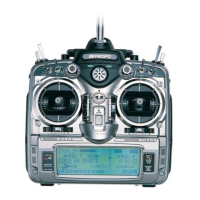• Do not lubricate servo gears or motors.
• Do not overload retract servos during retracted or extended
conditions. Make sure they are allowed to travel their full
deflection.
• Make sure that all servos move freely through their rotations
and that no linkages hang-up or bind. A binding control link-
age can cause a servo to draw excessive current. A stalled
servo can drain a battery pack in a matter of minutes.
• Correct any control surface “buzz” or “flutter” as soon as it is
noticed in flight, as this condition can destroy the model. It is
extremely dangerous to ignore such “buzz” or “flutter.”
Note: Coreless servos (all servos in the thousand series from
JR, e.g., 8231, 4721, 4131, etc., are coreless) make a slight
buzzing noise even at the center position. This is normal and is
caused by the motor constantly locking on its center position.
• Use the supplied rubber grommets and brass servo eyelets
when mounting your servos. Do not overtighten the servo
mounting screws as this negates the dampening effect of the
rubber grommets.
• Be sure that the servo arm is securely fastened to the servo.
• Check all related mounting screws and linkages frequently.
Vibrations may loosen the linkages and/or screws.
Radio controlled models are a great source of pleasure.
Unfortunately, they can also pose a potential hazard if not main-
tained and operated properly. It is imperative that you install your
radio control system correctly. Additionally, your level of piloting
competency must be high enough to ensure that you are able to
control your aircraft under all conditions. If you are a newcomer
to radio control flying, please seek help from an experienced pilot
or your local hobby shop.
Listed below are some safety precautions that must be followed
by all pilots:
• Make sure that your batteries have been properly charged prior
to initial flight and check the state of charge of your batteries
between flights.
• Perform a range check prior to the initial flight of the day. See
Section 13, Daily Flight Checks, for information on how to do
so.
• Check all control surfaces prior to each takeoff.
• Do not fly your model near spectators, parking areas, or at any
other place that could result in injury to people or damage to
property.
• Do not fly during adverse weather conditions. Poor visibility
can cause disorientation and loss of control of your aircraft.
Strong winds can cause similar problems.
• Do not fly unless your frequency is clear. Warning: Only one
transmitter at a time can operate on a given frequency. If you
should turn on your transmitter while someone else is operat-
ing a model on your frequency, both pilots will lose control of
their models. Only one person can use a given frequency at a
time. It does not matter if it is AM, FM or PCM—only one
frequency at a time.
• Do not take chances. If at any time during flight you observe
any erratic or abnormal operation, land immediately and do
not resume flight until the cause of the problem has been
ascertained and corrected.
10X MANUAL Airplane
69
General Notes
11
Servo Precautions
10

